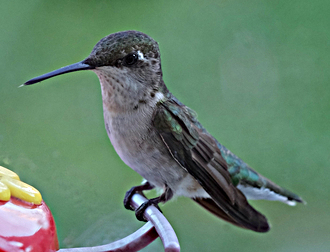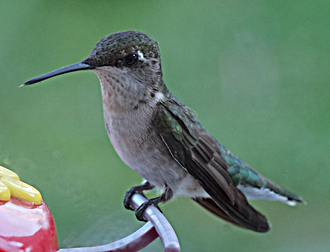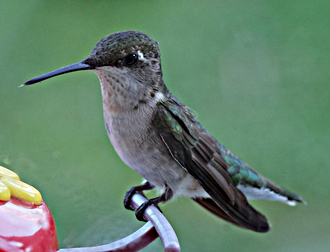Image Effects¶
Blur¶
New in version 0.4.5.
Basic blur operation. The radius argument defines the size of the area to
sample, and the sigma defines the standard deviation. For all blur based
methods, the best results are given when the radius is larger than
sigma. However, if radius is omitted, or zero valued, the value
will be selected based off the given sigma property.
with Image(filename="hummingbird.jpg") as img:
img.blur(radius=0, sigma=3)
img.save(filename="effect-blur.jpg")
Original |
Blur |

|
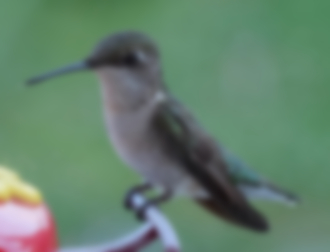
|
Adaptive Blur¶
New in version 0.5.3.
This method blurs less intensely around areas of an image with detectable edges,
and blurs more intensely for areas without edges. The radius should
always be larger than the sigma (standard deviation).
from wand.image import Image
with Image(filename="hummingbird.jpg") as img:
img.adaptive_blur(radius=8, sigma=4)
img.save(filename="effect-adaptive-blur.jpg")
Original |
Adaptive Blur |

|
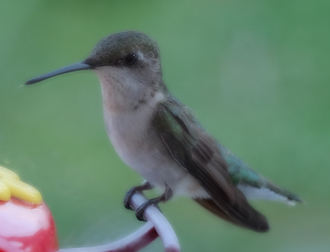
|
Gaussian Blur¶
New in version 0.3.3.
Smooths images by performing a Gaussian function. The sigma argument is
used to define the standard deviation.
from wand.image import Image
with Image(filename="hummingbird.jpg") as img:
img.gaussian_blur(sigma=3)
img.save(filename="effect-gaussian-blur.jpg")
Original |
Gaussian Blur |

|
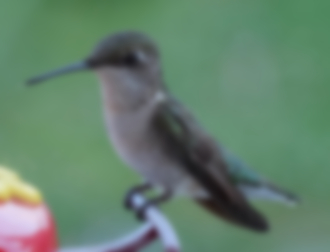
|
Motion Blur¶
New in version 0.5.4.
Performs a Gaussian blur operation along a linear direction to simulate a
motion effect. The radius argument should always be larger than the
sigma argument, but if the radius is not given (or 0 value) the
radius value is selected for you.
from wand.image import Image
with Image(filename="hummingbird.jpg") as img:
img.motion_blur(radius=16, sigma=8, angle=-45)
img.save(filename="effect-motion-blur.jpg")
Original |
Motion Blur |

|

|
Rotational Blur¶
New in version 0.5.4.
This method simulates a motion blur by rotating at the center of the image.
The larger the angle, the more extreme the blur will be.
Unlike the other blur methods, there is no radius or sigma arguments.
The angle parameter can be between 0° and 360° degrees
with 0° having no effect.
from wand.image import Image
with Image(filename="hummingbird.jpg") as img:
img.rotational_blur(angle=5)
img.save(filename="effect-rotational-blur.jpg")
Original |
Rotational Blur |

|
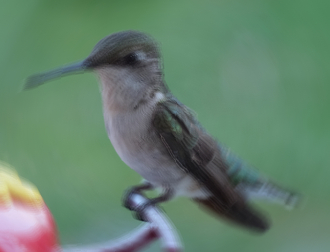
|
Selective Blur¶
New in version 0.5.3.
Similar to Image.blur() method, this
method will only effect parts of the image that have a contrast below a given
quantum threshold.
from wand.image import Image
with Image(filename="hummingbird.jpg") as img:
img.selective_blur(radius=8,
sigma=3,
threshold=0.25 * img.quantum_range)
img.save(filename="effect-selective-blur.jpg")
Original |
Selective Blur |

|

|
Despeckle¶
New in version 0.5.0.
Despeckling is one of the many techniques you can use to reduce noise on a given image. Also see Enhance.
from wand.image import Image
with Image(filename="hummingbird.jpg") as img:
img.despeckle()
img.save(filename="effect-despeckle.jpg")
Original |
Despeckle |

|
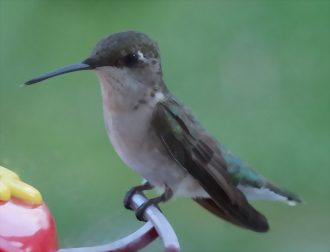
|
Edge¶
New in version 0.5.0.
Detects edges on black and white images with a simple convolution filter. If used with a color image, the transformation will be applied to each color-channel.
from wand.image import Image
with Image(filename="hummingbird.jpg") as img:
img.transform_colorspace('gray')
img.edge(radius=1)
img.save(filename="effect-edge.jpg")
Original |
Edge |

|

|
Emboss¶
New in version 0.5.0.
Generates a 3D effect that can be described as print reliefs. Like Edge, best results can be generated with grayscale image. Also see Shade.
from wand.image import Image
with Image(filename="hummingbird.jpg") as img:
img.transform_colorspace('gray')
img.emboss(radius=3.0, sigma=1.75)
img.save(filename="effect-emboss.jpg")
Original |
Emboss |

|
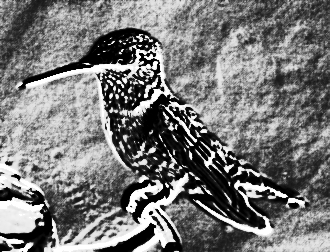
|
Kuwahara¶
New in version 0.5.5.
Warning
Class method only available with ImageMagick 7.0.8-41 or greater.
The kuwahara() method applies a smoothing filter
to reduce noise in an image, but also preserves edges.
from image.wand import Image
with Image(filename="hummingbird.jpg") as img:
img.kuwahara(radius=2, sigma=1.5)
img.save(filename="effect-kuwahara.jpg")
Original |
Kuwahara |

|

|
Shade¶
New in version 0.5.0.
Creates a 3D effect by simulating light from source where aziumth controls
the X/Y angle, and elevation controls the Z angle. You can also determine
of the resulting image should be transformed to grayscale by passing gray
boolean.
from wand.image import Image
with Image(filename="hummingbird.jpg") as img:
img.shade(gray=True,
azimuth=286.0,
elevation=45.0)
img.save(filename="effect-shade.jpg")
Original |
Shade |

|

|
Spread¶
New in version 0.5.3.
Spread replaces each pixel with the a random pixel value found near by. The size of the area to search for a new pixel can be controlled by defining a radius.
from wand.image import Image
with Image(filename="hummingbird.jpg") as img:
img.spread(radius=8.0)
img.save(filename="effect-spread.jpg")
Original |
Spread |

|
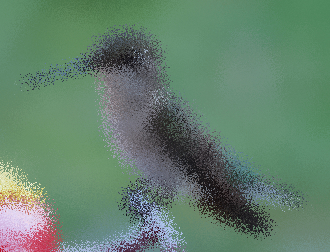
|
